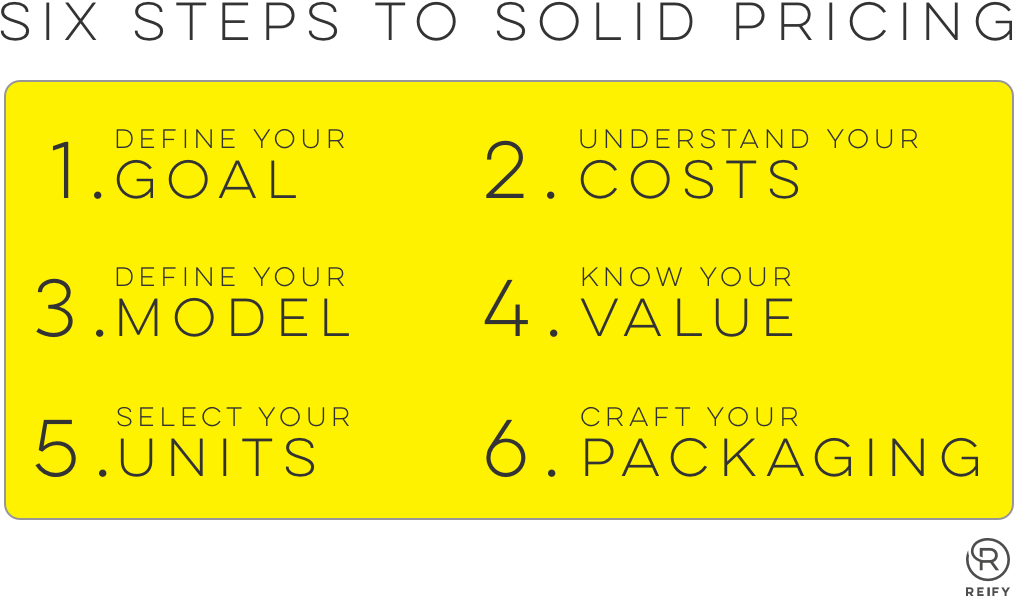Aka: how we respond when asked “how much should we charge for this?”

We’re partnering with Heavybit to host a 1-day conferenced focused exclusively on pricing strategy in San Francisco. Register now to join 120 founders learning about pricing strategies packaged for growth and profitability.
Pricing and Packaging projects are exciting for us to work on because these decisions have a high impact on the success of a company. Pricing and packaging is about far more than just how much you’re going to charge. Developing a cohesive pricing strategy certainly includes how much you should charge (the price point), but we need to start from the beginning.
Here’s a quick introduction to the process we use with clients when developing their pricing and packaging strategy :
Start by defining your goal
This is the most important step in developing your pricing strategy, and it can be a difficult decision. Are you looking for market share, near-term revenue, lifetime customer value, or profit? While these goals all sound good, you can’t build a pricing model that optimizes for all of them. A model built to drive market share will prefer new customers over the total revenue per customer, for example.
Your current runway, funding status, investors, product-market fit, and the experiences you and your co-founders have are all influences on this decision. We lead these conversations carefully, providing pros and cons of different approaches, and document a goal everyone can get behind.
Understand your costs
If you don’t have this info handy, you’ll want to understand your Cost of Goods Sold (COGS). This is often not very precise in the early stages of a company, but estimations can go a long way. What if you had another 1,000 customers tomorrow, how much more infrastructure would you need to pay for? What about another 10,000 customers? Do you have fixed costs per customer? Here are some good recommendations on how to determine your COGS. You may not base your pricing on your COGS, but you absolutely should know what your costs are as you’re finding the right model.
How you charge is often more important than what you charge
That line comes from one of our favorite books on the subject — Monetizing Innovation. There are dozens of pricing strategies you might consider. I’d highly recommend skimming over the Pricing Strategies wikipedia page to open your mind on what is possible.
Tomasz Tunguz has a great post on The Three-Part Tariff model, which we love. It’s a great example on packaging too — with a “platform fee”, plans that include a fixed number of units, along with overage fees. There’s an interesting research paper linked on that blog that shows the effect of this model on customer behavior that’s worth a read.
Value-based Selling and the Willingness to Pay
Cost-based selling is when it costs you $1 to make a widget and you sell it for $3. Value-based selling is when you work with your customers and prospects in your target market to understand the true value your product or service brings to them, and charge based on that.
To figure out what your customers are willing to pay you need to talk to them. Here’s our approach to customer interviews that you can use — including the interview template.
What unit(s) are you selling?
Before determining a price point, you need to determine what your units are. Are you charging based on usage, the number of users, a period of time, the number of products/features, or some combination of those?
Putting it all together — packaging plans
You have your goal set. You know what value your customers get with your product. You’ve selected a model that fits your goals and your buyer persona. You know what units you’re charging for. Now it’s time to put that all together into packages that your customers can buy. The Monetizing Innovation book recommends the following:
The ideal distribution of customers for a Good / Better / Best product configuration strategy is 30 percent in good and 70 percent in better and best, with best being at least 10 percent.
Take this into consideration when building your pricing plans, and keep an eye on those metrics as you grow. If you have too may customers in your lowest tier — you’re giving too much away. If you have too many customers in your highest tier — you’re not differentiating it enough and you’re leaving money on the table.
Additional Reading
Here are a few posts we’ve written that expand on pricing and packaging. Get in touch with us if you’d like to work with us directly, and learn more during our pricing conference this November.
- Land and Expand Strategies at GitHub and New Relic
- The upmarket SaaS trend is real, and it’s awesome
- The “Closing Big Deals” Starter Pack
- Resisting the urge of freemium
- Having trouble pricing? Look at your usage data!
